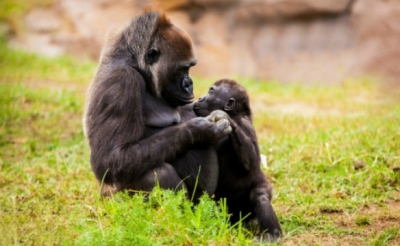
Strange are the ways of the animal world. We think animals are “dumb”, but they have surprising ways of talking to each other. How do animals say “Hey, want to play chase-the-tail?” or “You think we can eat this?” Animal languages don’t have names and we can’t tell what they are saying, but we do know that dolphins whistle, hyenas laugh, wolves howl, lions roar, elephants trumpet, birds whistle, tweet and chirp, frogs croak – to send messages across. And making sounds isn’t the only way they can say “I love you!” They use a dictionary of non-verbal means!
Touch
Chimpanzees greet each other by holding hands, monkeys groom each other by picking off dead skin. Pets and domestic animals lick to show affection. But elephants would be the best examples for communicating through touch. They deliberately touch one another with their trunk, tusks, feet, tail and sometimes through their entire body – to explore, play, protect, fight. Have you seen elephants greeting others with a raised trunk? Use their ears to rub a mate affectionately? Push a calf to join the queue? So it is a crime to keep elephants alone!
Colour
The male koel has a shiny coat, the peacock is a vision when it spreads its wings full of “eyes”. Leaf insects sit on green leaves, stick insects look like dry sticks. Brightly-coloured butterflies are either poisonous butterflies.
Big cats merge beautifully with the tall, dry grass. The fennec fox that lives in deserts has a coat in sand-colour. Using the colour of the background to hide is called “concealing colouration.”
Doesn’t the chameleon change colours repeatedly to match its changing habitat?
Chemical marking
The dog sniffs and pees from time to time on the sidewalk to mark its territory. This “chemical communication” is mostly through pheromones (substance released to convey a message) and through body fluids such as urine and venom. Chemical signals can be air-or-waterbone. You see, snakes can “taste” enemies from a distance by using their forked tongues and the roof of their mouth to collect pheromones. Most big cats mark their territory by urinating. Dogs sniff each other’s hindquarters for information. Cats rub their heads against a person or object to release pheromones to say, “You’re mine!”
Auditory
Animal cries signifying danger or distress are now understood well by humans. Sound travels long distances and becomes an effective medium of communication. Almost all animals call – the cuckoo sings to find its mate, doves coo, frogs croak, male crickets chirp to attract and to warn. Female cicadas respond by snapping their wings. Mammals in the oceans, like whales and dolphins, “speak” at ultrasonic frequencies to communicate over long distances, since visibility is poor in water.
Picture Credit : Google

